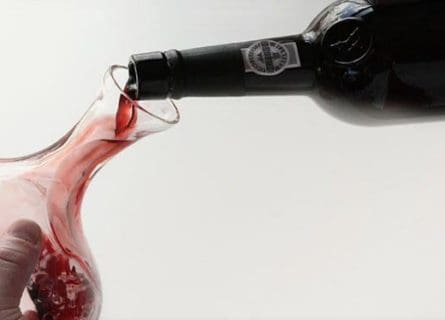
Unveiling Excellence: The 10 Top Vintage Port Wines for Discerning Palates
October 3, 2017
Savor Perfection: Unveiling the Finest Vintage Port Wines. Embark on a journey of excellence to delight your palate. Uncover the pinnacle of Port wines.
By: Nicole Indovino / Last updated: January 29, 2025
Sherry is a wine unlike any other crafted in the sun-drenched region of Spain, affectionately known as ‘Jerez.’ This unique fortified wine is shaped by the hot, arid climate and a distinctive aging system, which produces a wide array of styles, ranging from bone dry to lusciously sweet dessert wines. Its character is truly one-of-a-kind.
Sherry is not just a wine; it’s a living testament to history, tradition, and terroir. Its roots can be traced back to the 13th century when the region was under Moorish rule. The name Sherry itself is a nod to this history, derived from the town Jerez, which the Moors called Sherish. Today, many producers like Bodegas Tradición continue the tradition of Sherry, a heritage passed down in families for generations, adding to its cultural and historical significance.
In this comprehensive guide, we will delve into the rich history of Sherry, unveil its unique winemaking processes, and explore the diverse styles it offers. By the end, you’ll have the knowledge to appreciate and enjoy this exceptional wine!
Discover More About Spanish Wine
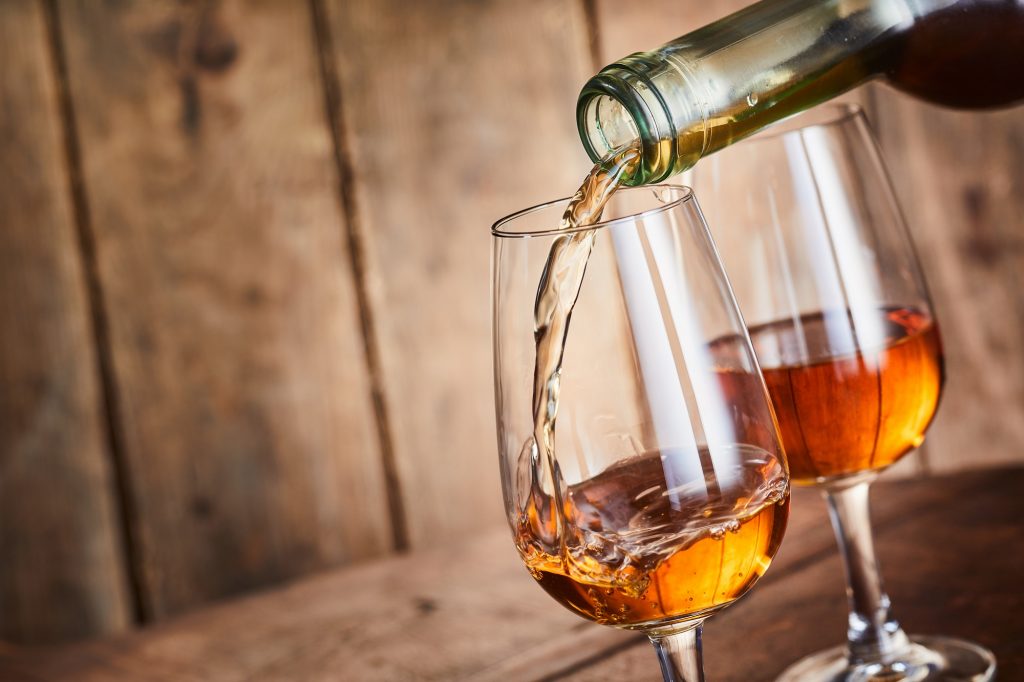
So, how did Sherry come to be? Although Islamic rule forbade alcohol consumption, winemaking persisted in the region for trade purposes. The Moors introduced the process of distillation to the area, creating a grape liqueur, a vital ingredient in sherry wine. This prevented spoilage when shipped on long sea voyages during the age of exploration. There was likely at least one barrel of Sherry on Columbus’ ship to the New World!
It wasn’t until the 16th century that Sherry exploded in popularity in England, where they called it ‘sack,’ a term derived from the Spanish word ‘saca’—meaning ‘to withdraw’- a reference to extracting wine from the bottom barrels in the solera system (see below). It was even referenced in some of Shakespeare’s plays. The English taste for Sherry developed rapidly after Sir Francis Drake plundered Cadiz in 1587 and returned to England with 2,900 barrels of Sherry.
Over time, as relations between the two countries improved, the Sherry trade thrived. British and Irish merchants established themselves in the towns of Puerto Santa Maria and Jerez in the heart of the Sherry region. They shipped Sherry to England in oak barrels, and once emptied, Scottish and Irish Whiskey makers used the barrels for aging. Today, some whiskey makers still age their whiskeys in Oloroso or Pedro Ximénez casks, adding unique flavors.
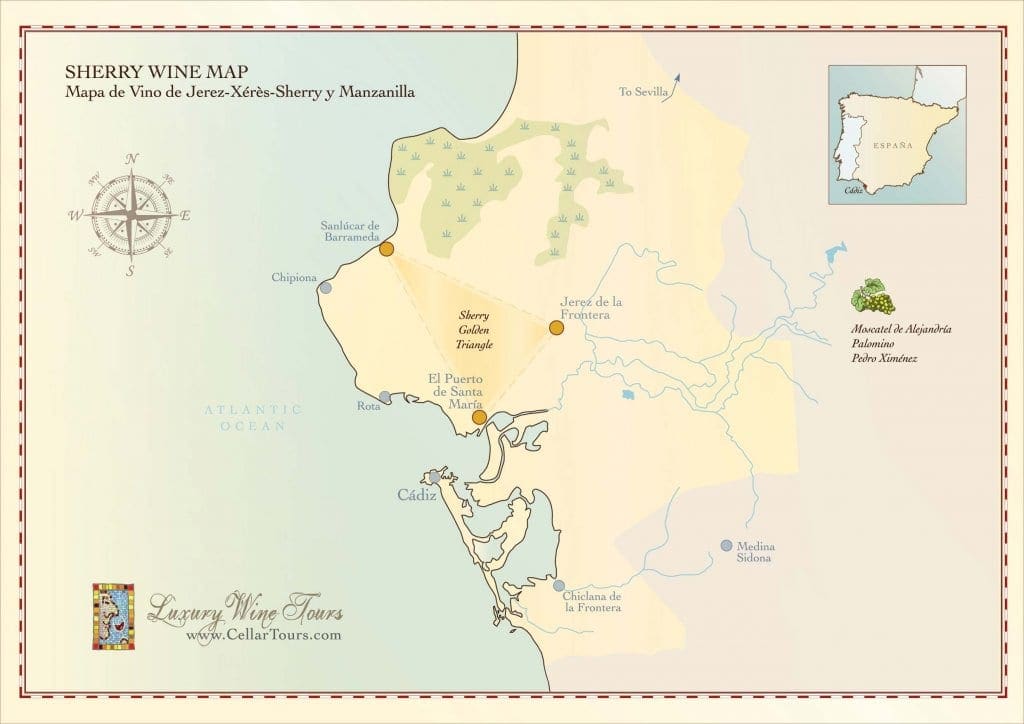
Sherry’s production is centered in the south of Spain, specifically Andalucía. The region is known as the ‘Sherry Triangle .’ Jerez, El Puerto de Santa Maria, and Sanlúcar de Barrameda, the three main Sherry-producing towns, form this triangle. However, since 2022, the Denominación de Origen of Jerez has officially added new areas, including Chiclana, Chipiona, and Trebujena, extending the triangle.
The Sherry Triangle, the heart of Sherry production, is a region of unique characteristics. It boasts a hot, arid climate with more than 300 days of sunshine yearly. The vineyards are found on rolling hills that mimic waves along the landscape. Atlantic winds provide a refreshing breeze and humidity for the vines.
The unique soil of ‘albariza,’ consisting of marine sediments, limestone, and prehistoric sea fossils, blesses these vineyards. With its strikingly white, chalky appearance, this soil reflects sunlight onto the grapes, enhancing their flavor. It also has a crumbly, light texture with excellent water-holding capacity, which is an asset in this dry environment.
Sherry’s production relies on three main grapes: Palomino Fino, Pedro Ximénez, and Moscatel.
Palomino Fino, a white wine grape, dominates this region, making up 95% of Sherry’s production. This grape variety thrives in this area, can withstand drought, and grows well in limestone soils. Palomino Fino is known for its neutrality, which is not very floral or acidic, allowing the terroir of the albariza and the specific aging process of Sherry to stand out in the wine.
Pedro Ximénez, another white grape, is an indigenous variety to Andalucía known for producing sweet, molasses-like wines. Legends claim the soldier Pedro Ximen brought this grape from Germany to the south of Spain centuries ago, where it was widely propagated. However, DNA samples have proven the grape is indigenous to the region and an offspring of a Moorish varietal. Once harvested, these grapes are left to dry in the hot sun, concentrating their sugar to make sweet, luscious dessert wines.
Moscatel, another white grape often used to make dessert wines, is the smallest production within the Sherry Triangle. Moscatel vineyards typically sit on sandy soils near the sea and are known for their beautiful floral aromas of orange blossom and jasmine.
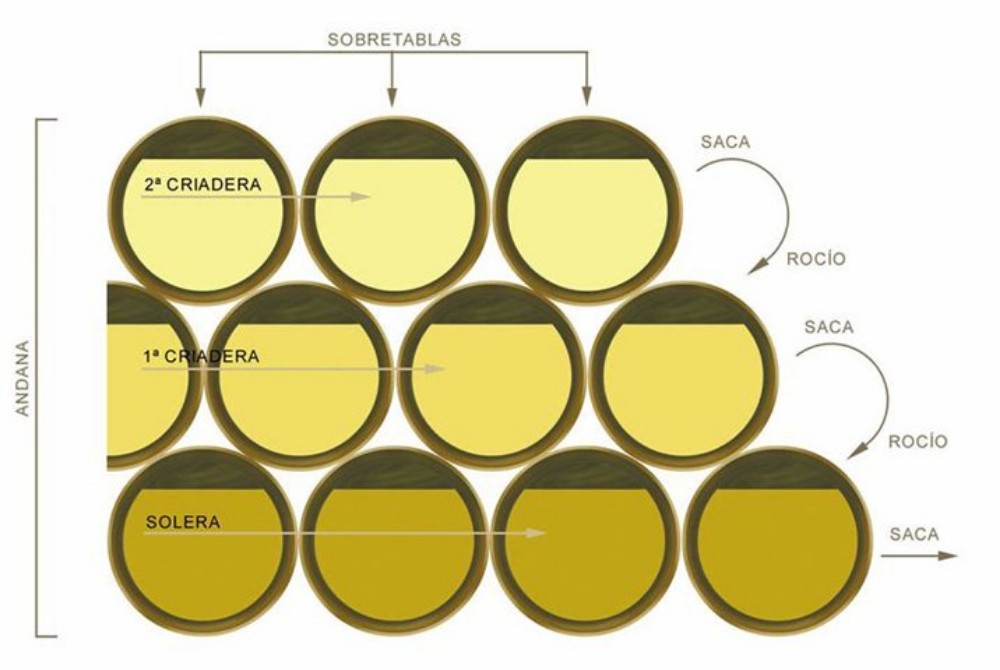
Sherry’s production process is a fascinating journey. Like any other wine, it begins with grape harvesting and fermentation. But here’s where it gets interesting—the aging process.
After fermentation, the wines are fortified with a distilled grape spirit. For ‘finos,’ the fortification process continues until they reach a total alcoholic content of 15 percent by volume. In contrast, fuller styles like ‘olorosos’ are fortified until they reach a minimum of 17% by volume. The wines are then barrelled in butts (600-liter oak barrels) and set aside for six months to a year in a process called ‘sobretabla.’
Next comes the aging process, with Sherry undergoing biological and oxidative aging to create different styles of wines.
Solera System (Oxidative Aging)
Sherry has pioneered an ingenious system of maintaining consistency of quality and character by blending younger and older wines for several years. A solera comprises several barrels called criaderas (clase is used instead of criadera in Sanlúcar). A Sherry solera usually contains three or four levels of criaderas, each containing wines of a different age.
The first criadera contains the youngest wines, known as the ‘sobretable’; the second criadera has the next youngest wines, and so on, until you get to the solera row containing the oldest blends. When it’s time to bottle a finished Sherry, wine is removed from the solera row (this process is called the saca), with wine from the oldest criadera replacing what was taken. In turn, wines are taken from each previous criadera to refill the next-oldest criadera. Finally, fresh wine is used to top up the first criadera.
Some solera systems are over 100 years old, blending decades of different vintages in a long-lasting tradition to create a unique wine that captures history in a glass.
Biological Aging Using Flor (White yeast)
However, there are variances depending on what the winemaker seeks to create. In the case of finos, younger wines are used to pass nutrients onto older vintages to keep the flor alive. This enigmatic yeast, which forms like an albino skin on the surface of the wine, is indigenous to Jerez and plays a number of roles. First and foremost, it protects the wine from oxidation, imparting a distinctive flavor we call ‘rancio.’ Therefore, the sherry will be bottled while the flor is still active. But in the case of amontillados, the wines are left to age after the flor has died before they are removed from the cask. Like finos, amontillados will lose a small percentage of alcohol during aging and will, therefore, be refortified.
Yet oloroso requires no such treatment; the sherries increase their alcoholic strength, as moisture can evaporate from the barrel over time without the covering of flor. The final ABV is typically between eighteen to twenty degrees. Occasionally higher.
In 2000, the Consejo Regulador introduced two new categories to highlight the exceptional quality of certain sherry wines that have been aged for a long time. These categories are V.O.S. for Sherries aged over twenty years and V.O.R.S. for those aged over thirty years.
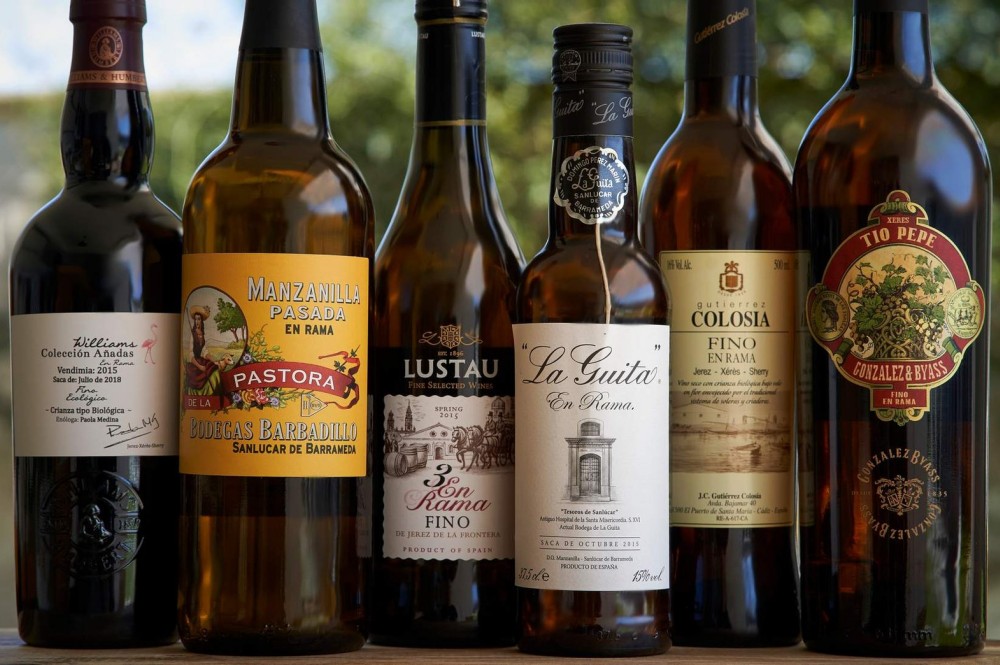
Sherry offers several different styles ranging from bone-dry to syrupy sweet. This variety comes from different aging styles (biological or oxidative), grape types, and sugar levels, creating options for different palettes, food pairings, and occasions. Here, we will dive into the various styles:
Fino Sherry
Made from Palomino Fino grapes, Fino is the driest of Sherry styles. These relatively young fortified wines are aged biologically under the flor yeast and spend about 5 years in solera. They have intense notes of almonds and herbs with a curious saltiness.
Manzanilla
Salt-licked manzanilla is possibly our favorite type of sherry. It shares many similarities with fino and a similar amount of time in the solera system; however, it can only be made in Sanlucar de Barrameda. Sanlucar’s humid climate encourages the growth of a thicker layer of flor, creating a pungent, fresh, and saline style of wine. It is divine with seafood tapas. The coastal influence heightens the wine’s saltiness, which often has more floral notes than interior Finos.
Amontillado
Amontillado combines biological and oxidative aging from Palomino Fino grapes. The wines begin their lives, destined to become Finos or Manzanillas. However, when their flor naturally dies off, they are sent to the soleras to finish and spend ten or more years in the solera system. This creates an interesting blend of both styles, maintaining some of the dryness and saltiness of Fino but with sweeter aromas and rich flavors of caramel and chocolate.
Oloroso
Oloroso means fragrant in Spanish and gives off strong aromas of walnuts, balsamic, and dried fruits. A winter favorite, oloroso is the polar opposite of fino sherry. It is made differently, with a darker color, richer palate, higher alcohol, and a surfeit of oxidative flavors. It is not given a protective yeast blanket, instead being allowed to develop slowly in the barrel over many years. A fine dry Oloroso is usually as lively as an Amontillado, even though the latter spent the early part of its life protected from aeration. However, it is typical for much older stocks to be blended in with younger wines to create high-end reserve wines. These wines rarely indicate an age on the bottle, but they can contain elements that are well over 100 years of age. The result can be a magical combination of weight and complexity.
Palo Cortado
Palo Cortado is known to be the most mysterious of all the Sherry styles. Historically, they would begin aging under flor. However, they inexplicably lose their veil (‘cortado’ refers to being cut short) and are further fortified and aged as Olorosos.
These days, Palo Cortado is rarely under flor; instead of letting it develop a layer of flor, it is fortified to an Oloroso level and ages oxidatively. They have a rich bouquet of nutty, caramel aromas with a similar sweetness to Olorosos while maintaining some of the sharpness of an Amontillado.
Pedro Ximénez
The process required to make PX sherry is long and complex. After the harvest, the bunches are traditionally left on esparto grass mats for 15-20 days, desiccating the grapes in the warm Andalucian sun. As a result, the berries lose much of their water content while residual sugars and acids are concentrated. When the sugar level reaches about 500 grams per liter, the raisened berries are pressed, releasing a very sweet, dark must. This juice is then fermented until the winemaker judges it is time to add pure grape spirit, fortifying the sweet wine to about 15% ABV. Finally, the lees are removed via filtration, and the wine is placed into the time-honored sherry maturation system using old American oak barrels.
But there are also key points of difference. Unlike fino sherries, the winemaker will not encourage flor (yeast) cells to develop a fine layer over the fortified wine, protecting it from oxidation. Moreover, the maturation process for PX differs as the wines are denser; they do not interact with the interior of the cask in the same way; hence, their evolution is slower, and therefore, the blending stages will take longer. The finest cuvées may be aged for several decades before they are sold. A curious feature of PX sherry is that it loses alcohol as it ages. For that reason, the sherry may be refortified before it is bottled. They are among the most decadent and complex dessert wines being made in Europe today.
Cream Sherry
Historically made for the British market, cream sherries blend Oloroso and Pedro Ximénez, giving a very creamy texture to this rich dessert wine. Often, Sherry has the reputation of being a sweet, low-quality wine that belongs to our grandmothers, and much of this comes from Cream’s explosion in the UK and the mass production that followed. However, as we have seen above, there are so many different styles and levels of quality for all kinds of drinkers.
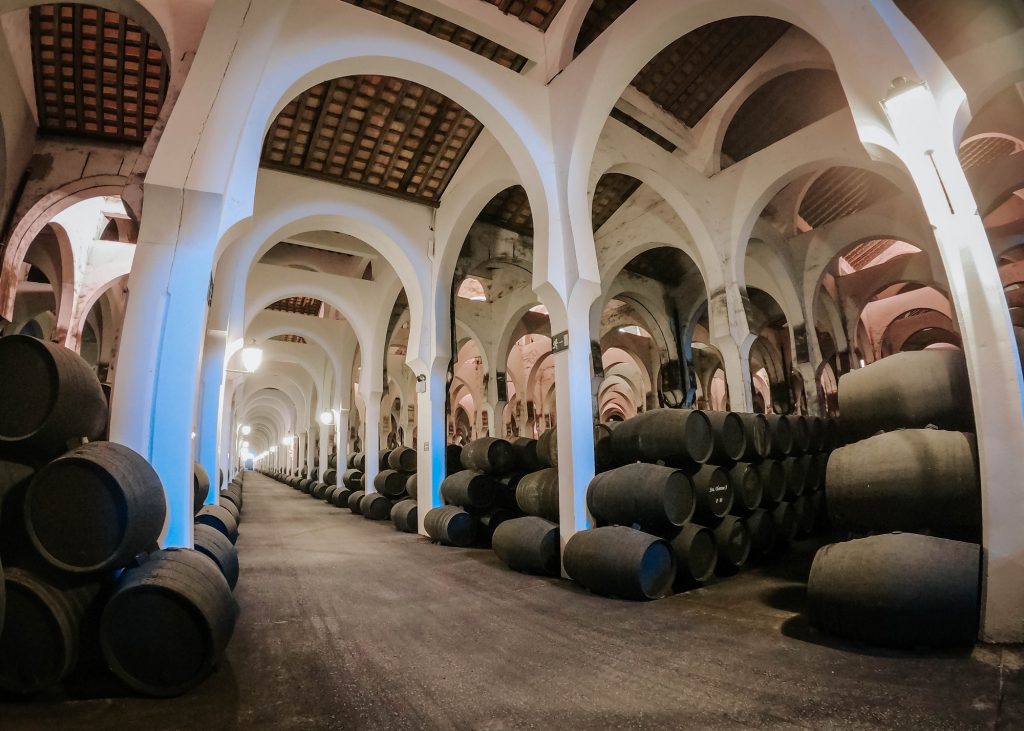
Sherry wineries ‘bodegas’ have a unique architecture to accommodate the wine aging process. Sherry wines require fresh air, humidity, and cooler temperatures for the flor to survive and to minimize evaporation. Sherry wineries have high ceilings to promote airflow and strategically oriented windows allowing Atlantic sea breezes.
Thick walls maintain stable temperatures and humidity. Floors made of albero, a sandy clay material also used in bullrings, can be sprinkled with water to promote even more humidity. These practical architectural choices create cathedral-like bodegas that are incredibly beautiful and filled with the aromas of old, aging Sherry casks—an unforgettable memory.
So, what’s the best way to drink Sherry? First, chilling the wines is essential. Chill and serve your Finos and Manzanillas to around 5-9ºC (40-50ºF). Amontillados, Palo Cortados, and Olorosos are best enjoyed when served at 10-14ºC (50-60ºF).
Drinking Sherry from a normal white wine glass is acceptable and recommended. However, Sherry-specific glassware, such as a schooner, is regularly used in Spain, particularly in Andalusia.
What about storage? Storing Sherry bottles in a dark, cool place is essential, like all wines. Finos and Manzanillas should be opened within 1-2 years of purchase. Once opened, these wines last 1-2 weeks in the refrigerator. You can store Oxidative styles (Oloroso, Palo Cortado, Amontillado, Cream Sherry, Pedro Ximénez) for extended periods (3 to 5 years) before consumption. Once opened, they will last up to two months, in or out of the fridge.
Sherry excels in food pairing due to its versatility, umami richness, and savory characteristics. Finos and Manzanillas are great aperitifs and go well with jamón ibérico, olives, salty mojama and tortilla. It is also an incredible match with seafood, like prawns, octopus, or sushi. Medium-bodied Palo Cortados and Amontillados complement savory dishes, including asparagus, artichokes, mushrooms, truffles, and more. Pedro Ximénez is an incredible dessert wine, delightful on its own but truly exceptional when paired with tiramisu, dark chocolate, or even blue cheese.
Sherry Vinegar
The Sherry Triangle also produces some other gourmet products along with incredible wine. One is ‘Vinagre de Jerez’ or Sherry vinegar. Sherry vinegar is aged using a process similar to that of sherry wine, adopting comparable methods to develop its rich, complex flavors. The Sherry Regulatory Council rigorously oversees the production of this product to ensure its high quality. It even has ‘reserva’ vinegar, a top gourmet choice for foodies and chefs to use while cooking or dressing salads.
Brandy de Jerez
Another excellent product from this region is Brandy de Jerez. Jerez’s production of distilled spirits dates back to Moorish rule when they used Palomino Fino. By the 17th century, Jerez was exporting Brandy to Holland. The term “brandy” originates from the Dutch word “brandewijn,” which means “burnt wine.”
Nowadays, they use a grape from the La Mancha region, Airen. However, they age the distilled spirit in reused Sherry casks of American oak, which imparts the flavors of the Sherry to create a brandy that can compete with Cognac in elegance. It has beautiful, rich notes of cloves and citrus and a long, dry finish.
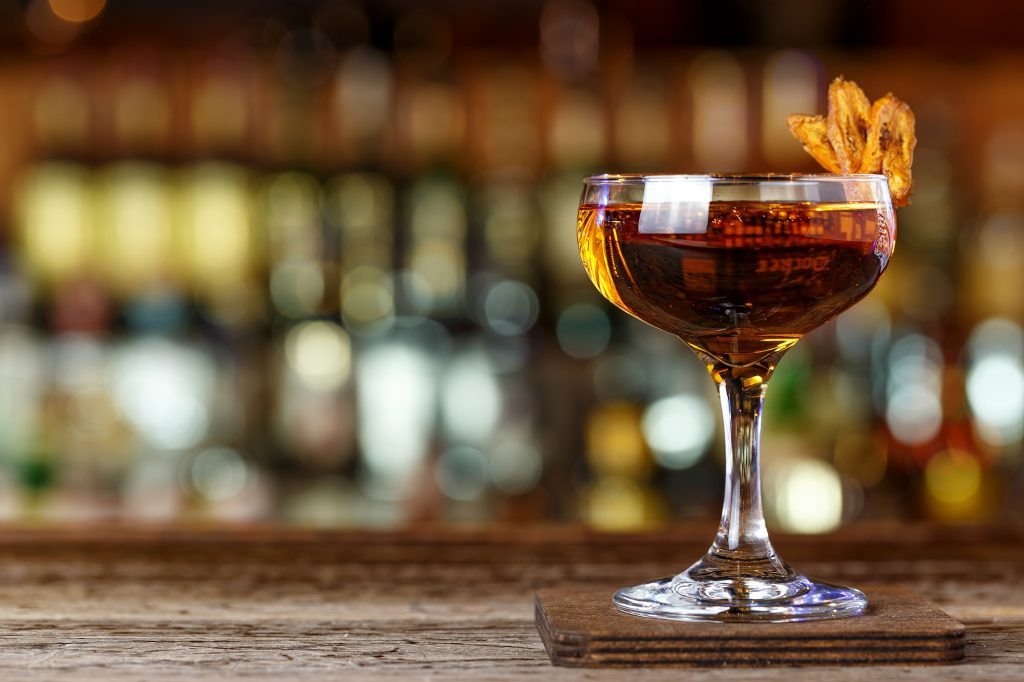
Sherry is expanding in the cocktail scene! Its complexity makes it a great option to go alongside other spirits or on its own for a lower-alcohol drink option. Some favorites include:
Fino Swizzle: Combine grenadine, Ruby Port, Brandy, and lemon juice over crushed ice and top it off with Fino Sherry and some bitters.
The Butchertown Cocktail: It resembles an old-fashioned, with Amontillado, rye whiskey, and some orange liqueur.
The Bamboo: If you want a lower-alcohol option, this is a classic: equal parts Sherry and vermouth, two dashes of orange bitters, and lemon peel, making an excellent lower-ABV martini.
Sherry is an incredibly unique wine that immediately connects you to the south of Spain and its essence. Nowhere else in the world will you find these cathedral-like wineries, complex solera aging systems, wines covered in flor, and wrapped in so much mystery. The range and diversity of the wines give you great options to pair with any food for any occasion. Every sip is like taking in history. Cheers!
If you would like us to customize an exclusive luxury tour, contact us and let us know your travel plans. We offer luxury food and wine tours for private groups of a mininium two guests. In addition, all of our private, chauffeured tours are available year-round upon request.

